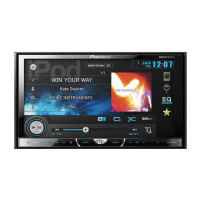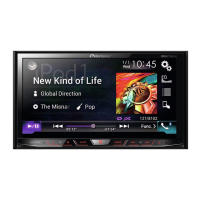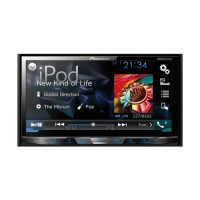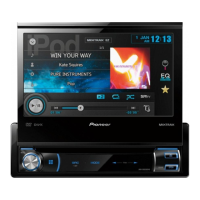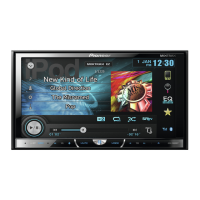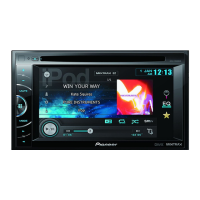How to fix no sound on Pioneer AVH-X3500BHS?
- BBrian BrightAug 18, 2025
If there is no sound or the volume level is low on your Pioneer Car Receiver, first adjust the volume level. If that doesn't work, check if the attenuator is on and turn it off.
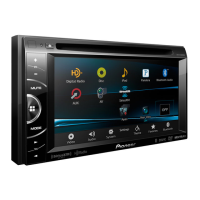
How to fix no sound on Pioneer AVH-X3500BHS?
If there is no sound or the volume level is low on your Pioneer Car Receiver, first adjust the volume level. If that doesn't work, check if the attenuator is on and turn it off.
What to do if my Pioneer AVH-X3500BHS Car Receiver power will not turn on?
If your Pioneer Car Receiver will not turn on, double-check that all leads and connectors are correctly connected.
What to do if my Pioneer Car Receiver says to check the speaker connection?
If your Pioneer Car Receiver displays a message to check the speaker connection, and the message persists after restarting the engine, seek assistance from your dealer or an authorized Pioneer Service Station.
Why is there no image displayed on my Pioneer AVH-X3500BHS?
If there is no image displayed on your Pioneer Car Receiver, it could be due to a few reasons. First, check if the disc loaded is compatible with your video system and change the disc if needed. Also, ensure that all cables are connected correctly.
What to do if playback is not possible on Pioneer Car Receiver?
If playback is not possible on your Pioneer Car Receiver, try cleaning the disc. If that doesn't work, check to make sure that the type of disc you are using can be played on the unit.
Why is my Pioneer Car Receiver stuck in slow motion?
If your Pioneer Car Receiver is stuck performing still, slow motion, or frame-by-frame playback, connect the parking brake cable, and apply the parking brake.
How to fix 'File size and transmission rate are above recommended rates' error on Pioneer AVH-X3500BHS Car Receiver?
To fix the 'File size and transmission rate are above recommended rates' error on your Pioneer Car Receiver, create a DivX file that is within the recommended size and transmission rate.
What to do if Pioneer Car Receiver says 'AMP Error'?
If your Pioneer Car Receiver displays an 'AMP Error', it means the unit is not operating correctly or the speaker connection is faulty, which has activated the protective circuit.
What to do if my Pioneer Car Receiver says 'Check that the disc is loaded correctly'?
If your Pioneer Car Receiver displays 'Check that the disc is loaded correctly', press the RESET button.
What to do if my Pioneer Car Receiver says 'The disc is dirty'?
If your Pioneer Car Receiver indicates that the disc is dirty, clean the disc.
| Brand | Pioneer |
|---|---|
| Model | AVH-X3500BHS |
| Category | Car Receiver |
| Language | English |
Essential guidelines for safe installation and operation of the display unit.
Warnings and restrictions related to driver attention and safe operation.
Explanation of how the parking brake system disables certain functions.
Advice on preventing battery drain while using the unit.
Details FCC/IC compliance, alterations, and notes on equipment operation.
Guidance on setting safe listening levels to protect hearing.
Explanation of manual conventions and structure.
Instructions for installing the battery, using the remote, and demo mode.
Identification of the main buttons and their functions on the head unit.
Description of the home screen layout and its key icons.
Procedure for powering the unit on and off using the SRC/OFF button.
Guide to choosing different audio and video sources available on the unit.
Explains common actions for navigating menus and lists.
How to use scroll icons and scrubber bars to view content.
How to use the touch-sensitive keys on the display.
Instructions for displaying the rear view camera image.
Connecting a rear monitor to view images and videos.
Enhances compressed audio quality by restoring rich sound.
Selecting appropriate screen ratios for video playback.
How to adjust the LCD panel angle and eject discs.
Explanation of HD Radio stations, features like PSD, HD2/HD3, Digital Sound.
Key functions for operating the HD Radio tuner.
Common operations for the tuner, like switching bands and seeking.
Steps to store and recall favorite radio stations as presets.
Automatically stores the six strongest stations based on signal strength.
Using local seek tuning for stations with strong signals.
Saving song information for later purchase via iTunes.
Selecting between digital and normal seek modes.
Automatic switching between digital and analog broadcasts.
Key functions for operating the tuner.
How to store and recall up to six stations per band.
Automatically stores the six strongest stations.
Using local seek tuning for stations with strong signals.
Saving song information for later purchase via iTunes.
How to control the SiriusXM Connect Vehicle Tuner.
Identification and function of touch panel controls for SiriusXM.
Common operations like tuning and seeking channels.
How to store and recall up to six SiriusXM channels per band.
Methods to select channels from all channels or categories.
Entering a channel number directly to select it.
Functionality to pause, rewind, or replay the current channel.
Saving song information for later purchase via iTunes.
How to lock channels and manage passcodes for parental control.
Setting the start position for audio playback when changing channels.
Using Tune Scan™ and Category Scan for previewing content.
How to play DVD, DVD-R/RW, CD, CD-R/RW movie files.
Identification of touch panel controls for disc playback.
Common playback actions like fast forward, stop, and eject.
How to listen to audio files from discs.
Switching between media file types on discs with mixed content.
How to navigate and select options from a DVD's menu.
Playing video/songs in a random order from selected lists.
Setting playback to repeat a track, chapter, title, or the entire disc.
Using search functions to find specific parts of a disc.
Switching audio output types for DVD video and Video CDs.
Information on playback control for Video CDs.
How to select tracks using the recorded track title list.
How to select files from a list of names for compressed audio/DivX.
Information on playing DivX Video on Demand content.
How to capture image data to use as wallpaper.
How to view video files from an iPod.
Identification of touch panel controls for iPod operations.
Common actions for playing iPod videos.
How to listen to iPod sound files through the car speakers.
Using the car's speakers for sound from iPod applications.
Playing songs or videos in a random order.
Setting playback to repeat a song or all songs.
How to play Movies, Music Videos, etc. from a connected iPod.
Browsing content on the iPod by category.
Using alphabet search mode to find specific titles.
Adjusting playback speed for audiobooks.
Viewing song lists from the currently playing album.
Overview of operating iPhone applications via the unit's screen.
Steps to install and launch AppRadio and other applications.
Configuring the keyboard language for text input.
Adjusting the volume mix between app sound and source sound.
How to view video files stored on a USB device.
Identification of touch panel controls for USB operations.
Common actions for playing USB videos.
How to listen to USB audio files.
Creating a database for easy browsing of songs by category.
How to view still images from a USB device.
Switching between media file types on USB devices.
Playing files in a random order.
Setting playback to repeat a file, folder, or all files.
How to select files from a list of names for compressed audio/DivX.
Viewing song lists from the currently playing album.
Information on playing DivX Video on Demand content.
How to capture image data to use as wallpaper.
How to listen to Bluetooth audio files.
Identification of touch panel controls for Bluetooth audio.
Steps to establish a Bluetooth wireless connection.
Playing audio files in a random order.
Setting playback to repeat a song or all songs.
Overview of MIXTRAX technology for creating non-stop mixes.
Using MIXTRAX EZ to add sound effects between songs.
How to initiate the MIXTRAX EZ feature.
Turning on MIXTRAX mode for audio playback.
Configuring sound effects and fixed sounds.
Saving custom sound effect combinations.
Requirements and procedures to play Pandora on Pioneer products.
Configuring connection mode for Pandora streaming.
Common operations for playing Pandora tracks, skipping, and sorting.
How to select and play stations or shuffle mode.
Identification of touch panel controls for Bluetooth telephone.
Steps for establishing Bluetooth connection and adjusting volume.
How to select and call contacts from the phone book.
Using alphabet search to find contacts.
Changing the order of first and last names for contacts.
Accessing and calling numbers from call history lists.
Configuring the unit to automatically answer incoming calls.
Adjusting the volume for the person on the other end of the call.
Dialing a number directly using the keypad.
Switching to private mode for direct conversation on the phone.
Using voice commands to make calls.
Accessing and customizing menu items.
Adjusting front/rear and left/right speaker balance.
Adjusting the balance between right/left sound output.
Lists available preset equalizer curves.
Adjusting equalization to match car acoustics.
Fine-tuning individual frequency bands for equalizer curves.
Turning the auto-equalizer on or off.
Easily creating sound suited for the listening position.
Compensating for low-frequency deficiencies at low volume.
Adjusting the bass level.
Filtering low sounds from subwoofer output.
Adjusting volume levels of different sources to match FM level.
Selecting a desired subtitle language for playback.
Selecting a preferred audio language for playback.
Setting the language for disc menus.
Enabling or disabling the angle icon for scenes with multiple angles.
Selecting display aspect ratios like 16:9 or 4:3.
Setting the time interval between JPEG images in a slideshow.
Setting parental lock levels and code numbers for restricted content.
Selecting whether to display DivX external subtitles.
Generating a DivX VOD registration code for content playback.
Configuring the unit to automatically play DVDs upon insertion.
Activating settings for auxiliary devices.
Activating settings for external video components.
Switching the RGB input setting for iPhone or NAVI.
Adjusting the volume mix between app sound and source sound.
Turning on MIXTRAX mode for audio playback.
Adjusting brightness, contrast, color, hue, dimmer, and temperature.
Changing the language for menus and text information.
Setting the start position for audio playback when changing channels.
Turning the demo screen on or off.
Managing sound muting or attenuation based on external signals.
Configuring rear output for full-range speakers or subwoofers.
Controlling continuous scrolling of text information on the display.
Configuring connection mode for Pandora streaming.
Activating the Bluetooth Audio source for audio players.
Deleting paired Bluetooth devices from the unit's memory.
Instructions for updating the unit's Bluetooth software.
Checking the version of the unit's Bluetooth module.
Configuring camera polarity for automatic rear view display.
Automatically measures and creates an auto-equalizer curve.
Step-by-step guide for measuring and setting auto EQ.
Selecting the appropriate video signal setting for AV equipment.
How to display, customize, and use favorite menus.
Procedures for connecting Bluetooth devices.
Steps to search for and connect Bluetooth devices.
Enabling automatic connection between devices.
Setting the unit's visibility to other Bluetooth devices.
How to enter and manage the PIN code for Bluetooth pairing.
Viewing the unit's unique Bluetooth device address.
Choosing from preset and custom illumination colors.
Changing the color of on-screen display elements.
Switching the background image displayed on the unit.
Calibrating touch panel accuracy for better response.
Connecting and using auxiliary devices or portable players.
Restoring the unit to initial settings without losing bookmark data.
Instructions for securely mounting the unit using screws.
Diagram and instructions for connecting the power cord and other wires.
Wiring diagrams for connecting to an external power amplifier.
Wiring instructions for connecting external video sources.
Connecting a rear view camera for automatic display.
Instructions for connecting an optional SiriusXM tuner.
Instructions for connecting an iPod/iPhone using the specific cable.
Details on aligning and fastening the unit to mounting brackets.
Guidance on microphone placement for optimal voice recognition.
How to adjust the microphone angle for clear voice capture.
Guidelines for using discs and the player, including compatibility.
Guidelines for using USB storage devices, including compatibility.
Precautions and tips for using USB storage devices.
Precautions and tips for using iPods with the unit.
Information on DivX file compatibility and usage.
Information on MPEG file compatibility and usage.
Details on WAV, WMA, MP3 file compatibility via USB.
Details on WMA, MP3 file compatibility via disc and USB.
Information on AAC file compatibility.
List of compatible iPod and iPhone models and software versions.
Explanation of the iTunes tagging function.
List of Bluetooth profiles supported by the unit.
Legal information regarding warranties and liability.
Copyright and licensing information for the libpng library.
A chart listing language codes for DVD playback.
Technical details including power, dimensions, and weight.
Technical details for the DVD player functionality.
Technical details for audio output and processing.
Technical details for USB connectivity and file handling.
Technical details for the FM radio tuner.
Technical details for the AM radio tuner.
Technical details for Bluetooth connectivity.
Performance specifications based on CEA-2006 standards.
Procedure for downloading firmware update files from Pioneer's website.
Steps for installing firmware updates onto the unit.
Instructions for connecting an iPhone 5 using specific cables and adapters.
Steps to pair and connect an iPhone 5 using Bluetooth.





